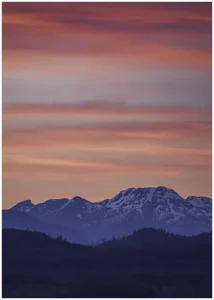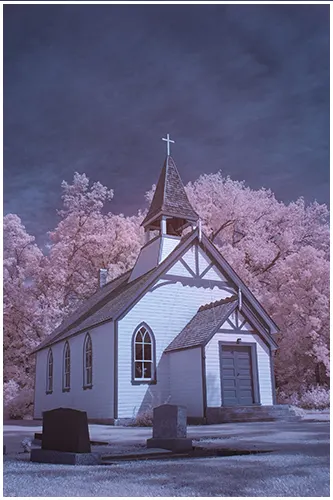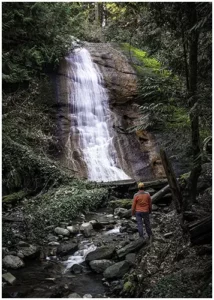
Harness the Power of Light and Shadow in Landscape Photography
In photography, light and shadow are essential for creating captivating photos. It’s important to grasp


Embarking on a visual journey that surpasses the ordinary, discover the transformative power of infrared filters for cameras. These special filters allow us to see a hidden world. Capture a surreal landscape where floral glows with a mysterious luminescence, and the skies deepen, conceive images that border on fascinating. Go beyond the limits of visible light by using IR filters and your digital camera.
No matter what option you choose for an infrared filter, such as a converted infrared camera or IR filters for a camera, they all allow infrared light in and change the way traditional photography is done.
IR photography unveils a hidden world of wonder, transforming the familiar into the surreal. With wavelengths starting beyond the red edge of our sight, infrared (IR) captures what can’t be seen with the naked eye. I want to help you understand the intricacies of IR photography and explore the world of unseen light and captivating images.
In the world of wavelengths, IR light exists just outside the spectrum visible to us, at around 750nm and above. The invisible light tells a quiet story of warmth and vitality, only revealed through specialized infrared filters for cameras.
Filters such as the R72 play a crucial role in capturing imperceptible elements. Essentially, they block visible light and only let IR waves pass.
Infrared filters are like special glasses for your camera lens. Cameras can capture light that our eyes cannot see by using IR filters. The science is simple: the filters block out visible light, allowing infrared light to pass through to the sensor.
Infrared radiation is emitted by all objects. A camera with an IR filter can capture and record this invisible light. The filter reveals a hidden world of contrasts and details, creating unique and surreal images that our eyes cannot detect.
Using an IR filter allows you to capture a different perspective in photography, showing the hidden beauty that we can’t see with our naked eyes. It’s a tool that adds an extra layer of creativity to your shots, turning ordinary scenes into extraordinary moments.
Our camera captures light that ranges from infrared (IR) to ultraviolet (UV). The point where IR starts marks the beginning of light beyond the colours we can see, allowing us to explore Wave Length (WL) that are usually invisible to us. IR, visible, and ultraviolet light have different wavelengths, offering great potential to push photography beyond what we can normally see.
| Spectrum | Wavelenght Range | Photographic Impact |
|---|---|---|
| Visible Light | 400 - 700 | Colours perceptible by the human eye |
| Infrared Light | 750 - 1000+ | Unseen beauty, ethereal landscapes |
| Ultraviolet Light | Below 400 | Generally filtered out in photography |
Learning about infrared-photography can be discovering something hidden and bringing it to light. Every time the camera captures an image, things that we can’t normally see become visible. Ordinary subjects suddenly shine brightly, connecting what is seen with what is not seen.
Discover a whole new dimension to your photography with IR filters! These magical accessories transform ordinary scenes into mesmerizing, otherworldly landscapes, giving your images an ethereal quality that captivates viewers.
Setting the white balance (WB) is crucial for calibrating images to achieve the desired mood and tonality. Modifying the camera sensor lets it capture invisible light, revealing a hidden world of light.
Here are a few IR shooting tips I’ve gleaned from my experience:
The following table compares the effects of using IR filters on different elements in a scene.
| Scene Element | Without IF filter | With IR FIlter |
|---|---|---|
| Foliage | Ordinary Green | Luminous and ethereal white glow |
| Sky | Typical blue or grey | Dramatically darkened with heightened contrast |
| Building Structures | Regular coloration depending on materials | Enhanced textures and contrast, often appearing more dramatic |
| Water Bodies | Regular coloration depending on materials | Can appear deeply dark or very transparent, depending on angle |
| Clouds | Detected by their shading | Stand out with pronounced definition against dark skies |
When looking for the right IR filter, focusing on the size and the wavelengths. The array of filter choices available can be daunting, but each serves a unique purpose for enhancing my IR photography ambitions—be it capturing the stark contrasts in landscapes or the subtle tones in a sky abundant with clouds.
When it comes to choosing between using a dedicated infrared filter or opting for a full spectrum converted camera, there are several factors to consider. Both options will allow you to explore IR photography and create unique images.
Grasping the mechanics behind the transmission curve chart is integral to predicting how my chosen filter will render the IR wavelengths. It’s more than just technical data—it’s a preview of the potential artistry, guiding you on how bright or dark infrared images will turn out, especially when photographing scenes that resonate with both colour and black details.
| Filter Type | Main Use | IR Wavelength Range (nm) | Visual Effect |
|---|---|---|---|
| 720nm IR Filter | Infrared Photography | 720+ | Deep Contrast, Monochrome |
| Clear Filter | Lens Protection | Full Spectrum | No Change in Image |
| Full Spectrum Filter | Full Spectrum Photography | Visible + UV + IR | Altered Colours, More Detail |
| IR Pass Filter | Scientific/Technical Use | Variable Based on Filter | Blocks Visible Light Completely |
| IR Blocking Filter | Daylight Photography | Below 700 | Prevents IR Light Affecting Image |
Taking infrared portraits is not just about capturing a person, it’s about delving into their soul through wavelengths that convey a deeper story. The portraits that used to be normal now have a creepy feeling, as the colours and textures of the skin look strange under this invisible light.
| Infrared Photography Element | Without Infrared Filter | With Infrared Filter |
|---|---|---|
| Foliage | Green and vibrant | Glowing with an otherworldly white |
| Skin Texture | Natural tones | Smooth, with a surreal touch. |
| Sky | Blue or grey, depending on weather | Often darker with pronounced clouds |
Through the lens of a infrared camera, each click and capture is an exploration into a spectral plane. Being able to see and capture all infrared light allows us to be more creative in both natural and urban settings. It’s not just a filter; it’s a way to see a new world, where the familiar becomes mysteriously unfamiliar.
To do IR photography, you need to be creative and have a good technical knowledge of the camera. Remember the IR Filter blocks out visual light once you attach the filter you’ll see nothing in the viewfinder.
First, set a custom white balance to capture the infrared light. This preliminary adjustment is something of a ritual; it’s where the dance with light truly begins. Not sure if you can set a custom white balance? Check your manual or check YouTube for the instructions. Look around for something green: tree branches, grass etc… take a shot without the IR filter on. Another way not often used is to use a grey card.
After capturing those raw infrared photos, it is in post-processing that the real transformation occurs. Investing time in Adobe Photoshop, particularly with the channel mixer, articulates the ethereal qualities of the capture.
You can also convert the image to Black & White. The truth is, some of my best B&W images started as IR photos
Pro-Tip
Infrared is not a solo act; it harmonizes well with multiple filters. You could use a red filter with your landscape IR photography to make the sky look darker and create strong contrasts with light-coloured foliage. Or, opt for a polarizing filter to manage lens flare and elevate the visual drama of the composition.
| Infrared Technique | Purpose | Settings/Tips |
|---|---|---|
| Custom White Balance | Achieve true-to-spectrum colours | Adjust white balance based on foliage or grass for a baseline infrared look |
| Channel Mixer Adjustment | Enhancing contrast and tone | Aim for a monochrome image by mixing red & blue channels in a 0-100 range |
| Multiple Filter Usage | To imbue distinct atmospheric effects | Pair an IR pass filter with a ND filter for long exposures during daylight |
In photography, technology and art come together to explore the unseen. Using an IR filter allows you to capture vivid contrasts and reveal infrared spectrum.
Indeed, harnessing the unseen beauty of the infrared light can propel your photography into a realm of endless creative possibilities. Through exploration, the extraordinary is unveiled in each frame, uncovering the invisible. It helps us appreciate the hidden beauty that surrounds us, waiting to be discovered.
Infrared filters block visible light and only allow infrared light waves through. Filters on camera lens capture “invisible light” beyond human vision.
Most digital cameras can be adapted for infrared photography by using a special filter or by removing the IR-blocking filter from the camera sensor. This makes the camera sensitive to infrared light, which is necessary for capturing infrared images.
Infrared photography can transform ordinary scenes into ethereal and surreal images. The phenomenon makes green leaves turn white and creates a dreamy effect in landscapes, enhancing the contrast between the sky and the objects. Infrared filters can also be used for unique portraits, creating distinctive skin tones and eye-catching effec
The 720nm marking on an IR filter indicates the wavelength of infrared light that the filter allows to pass through. Filters marked as 720nm (like R72) only allow light at and beyond this wavelength, typically resulting in images with prominent infrared effects where the foliage appears white and skies become dark.
To pick the right size infrared filter for your camera, check the lens diameter. Usually, the diameter is shown in millimetres (mm) on the lens or lens cap. This measurement corresponds to the filter size you need to purchase.
Deep IR filters, like the 720nm filter, only allow deep infrared light to pass, blocking most of the visible light spectrum and producing images with a distinct infrared look. Full spectrum filters allow the camera to capture all types of light, like visible, ultraviolet, and infrared. This provides flexibility to isolate different spectrums in post-processing or use specific on-lens filters for different effects.
Custom white balance is essential for accurate colours in infrared photography. Take a photo of something that reflects IR light (like green grass) using an infrared filter, then set the custom WB in your camera’s settings using this image.
Infrared images may need techniques like using a tripod for sharpness, trying different exposure settings, and possibly bracketing exposure. Additionally, focusing might need to be adjusted as infrared light can focus slightly differently than visible light.
Combining infrared filters with other types of lens filters can lead to unique artistic effects. For instance, you might use a polarizing filter to enhance sky contrast or coloured filters for creative colour effects in colour IR photography. Additional filters can reduce the amount of light that reaches the sensor. This may mean that adjustments to the exposure are necessary.
Post-processing is an important step in infrared photography to give the photos the unique visual style usually seen in IR photos. Techniques include adjusting levels and curves to increase contrast, channel mixing to swap colours (especially in colour IR), and fine-tuning hues and saturation to render the desired atmosphere and details in the image.

In photography, light and shadow are essential for creating captivating photos. It’s important to grasp

Looking to kill off an hour while in Nanaimo, BC? Just a short hop-skip and

Photography can be a fulfilling and enjoyable hobby that brings a creative outlet to your